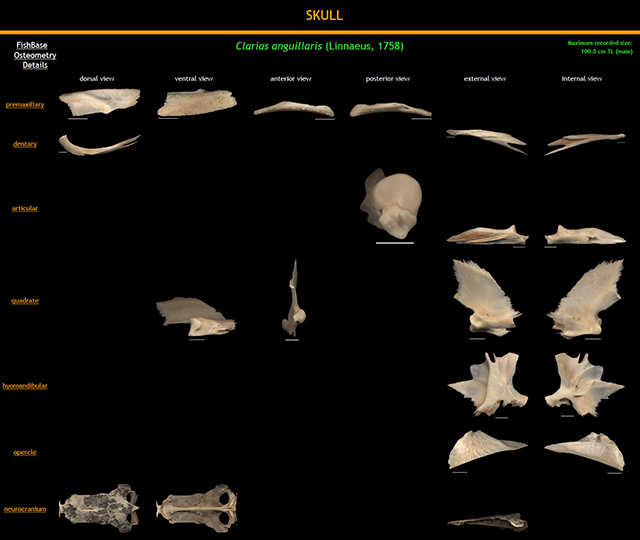Clarias
anguillaris
(Linnaeus,
1758)
Mudfish
View all media / Upload your photos and videos
Expand all
Classification / Names
Teleostei (teleosts) > Siluriformes (Catfishes) >
Clariidae (Airbreathing catfishes)
Etymology: Clarias: Greek, chlaros = lively, in reference to the ability of the fish to live for a long time out of water
More on author:
Linnaeus.
Environment / milieu / depth range / climate zone / distribution range
Distribution
Africa: lower and middle Nile; Chad system including the Logone and the Shari rivers; Niger and Benoue river systems; coastal rivers of Benin, Togo, Ghana and Côte d'Ivoire; Gambia and lower Senegal rivers; Volta system; relict populations occur in Mauritania and southern Algeria (Ref. 248). Also in the lower Cross in Nigeria (Ref. 81644). Trade restricted in FRG.
Size / Weight / Age
Short description
Dorsal spines (total): 0; Dorsal soft rays (total): 60 - 82; Anal soft rays: 42 - 61. Diagnosis: 16-50 gill rakers on first gill arch (much more reduced compared to Clarias gariepinus)(Ref. 57129, 81644), subject to geographical variations (Ref. 57129). Head oval-shaped to rectangular in dorsal outline; snout broadly rounded; eyes rather lateral in position and, together with relatively broad head, make for a relatively large interorbital distance; number of gill rakers on first branchial arch subject to much variation, 16-40, rarely exceeding 40; dorsal fin base situated close to occipital process; dorsal fin always terminates before caudal fin base, distance between both small; anal fin originates closer to caudal fin base than to tip of snout, nearly reaching caudal fin but never confluent; pelvic fin base slightly closer to tip of snout than to caudal fin base, reaching base of first anal fin rays; pectoral fin extend from operculum to base of first dorsal fin rays (Ref. 248). Pectoral spine slightly curved and robust (Ref. 248), serrated only on its outer side (Ref. 248, 81644), number of serrations increases with increasing standard length (Ref. 248). Lateral line appears as a small, white line running from posterior end of head to middle of caudal fin base (Ref. 248). Openings of secondary sensory canals (flank neuromasts) clearly marked, showing a regular pattern (Ref. 248, 81644). Description: number of gill rakers on first gill arch is subject to geographical variations, i.e., from 16 (specimen of 62mm SL) to 27 (specimen of 541mm SL) in the Chad basin, from 18 (83mm SL) to 37 (309mm SL) in coastal basins of Togo, in the Volta, coastal basins of Côte d’Ivoire and Gambia, as well as in the River Senegal, up to 40 in Mauritania, and 50 in the artificial lakes Kossou (Côte d’Ivoire) and Nungua (Ghana)(Ref. 57129). Coloration: 2 colour patterns can be discerned: the uniform and the marbled pattern (Ref. 248). In uniform pattern, specimens are uniform dark-brown, blackish brown or reddish brown on dorsal side and on flanks as well as on upper surface of paired fins, belly and lower surface of paired fins light brownish to beige (Ref. 248). In marbled pattern, back and flanks show irregular dark blotches on a light coloured background, belly and ventral parts of paired fins whitish (Ref. 248). Most specimens with pigmentation bands on both sides of lower surface of head; a series of light and dark bands may occur on caudal fin, proximal third of fin lightly coloured, while rest is darkly coloured; occasionally, irregular black spots occur on caudal fin and caudal peduncle (Ref. 248).
Biology
Very common in inundated areas. Bury themselves in the mud when the pools are drying up. Feed mainly on fish and mollusks; also crustaceans, diatoms, detritus and bottom organisms (Ref. 248). Omnivorous and reproduction takes place in the rainy saison (Ref. 78218). Max. size for West Africa and Lower Guinea: 650mm TL (Ref. 57129, 81644).
Life cycle and mating behavior
Breeding season varies among localities, apparently timed to the rainy season.
Main reference
Teugels, G.G. 1986 A systematic revision of the African species of the genus Clarias (Pisces; Clariidae). Ann. Mus. R. Afr. Centr., Sci. Zool., 247:199 p. (Ref. 248)
IUCN Red List Status (Ref. 125652)
Least Concern (LC); date assessed: April 28 2019
CITES (Ref. 131153)
Not Evaluated
CMS (Ref. 116361)
Not Evaluated
Threat to humans
Harmless
More information
- Countries
- FAO areas
- Ecosystems
- Occurrences
- Introductions
- Stocks
- Ecology
- Diet
- Food items
- Food consumption
- Ration
- Common names
- Synonyms
- Metabolism
- Predators
- Ecotoxicology
- Reproduction
- Maturity
- Spawning
- Spawning aggregation
- Fecundity
- Eggs
- Egg development
- Age/Size
- Growth
- Length-weight
- Length-length
- Length-frequencies
- Morphometrics
- Morphology
- Larvae
- Larval dynamics
- Recruitment
- Abundance
- References
- Aquaculture
- Aquaculture profile
- Strains
- Genetics
- Allele frequencies
- Heritability
- Diseases
- Processing
- Mass conversion
- Vision
- Pictures
- Stamps, Coins Misc.
- Sounds
- Ciguatera
- Speed
- Swim. type
- Gill area
- Otoliths
- Brains
Estimates based on models
Phylogenetic diversity index (Ref. 82804): PD50 = 0.5 [Uniqueness, from 0.5 = low to 2.0 = high].
Bayesian length-weight: a=0.00813 (0.00651 - 0.01014), b=2.97 (2.92 - 3.02), in cm total length, based on LWR estimates for this species (Ref. 93245).
Trophic level (Ref. 69278): 3.4 ±0.5 se; Based on food items.
Resilience (Ref. 120179): Medium, minimum population doubling time 1.4 - 4.4 years (Assuming tm=2-4; Fec < 10,000).
Fishing vulnerability (Ref. 59153): High vulnerability (60 of 100).
Price category (Ref. 80766): Unknown.
Nutrients (Ref. 124155): Calcium = 18.9 [9.6, 92.2] mg/100g; Iron = 1.21 [0.68, 2.07] mg/100g; Protein = 16.9 [15.9, 18.0] %; Omega3 = 0.207 [0.067, 0.587] g/100g; Selenium = 151 [51, 382] μg/100g; VitaminA = 24.3 [8.1, 69.9] μg/100g; Zinc = 0.721 [0.509, 1.023] mg/100g (wet weight);



